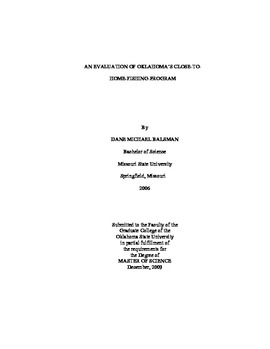| dc.contributor.advisor | Shoup, Daniel E. | |
| dc.contributor.author | Balsman, Dane Michael | |
| dc.date.accessioned | 2014-04-15T21:59:32Z | |
| dc.date.available | 2014-04-15T21:59:32Z | |
| dc.date.issued | 2009-12-01 | |
| dc.identifier.uri | https://hdl.handle.net/11244/9155 | |
| dc.description.abstract | The Close-to-Home-Fishing-Program (CTHFP) began in 2002 to provide anglers with fishing opportunities close to where they live. This study evaluated the program using a 2-year creel survey and channel catfish population sampling. Angler demographics, preferences, and behaviors were compared among anglers utilizing the CTHFP (trout and non-trout anglers), the general population (using 2000 Census data), and state-wide fishing license holders. Users of the CTHFP during the non-trout season tended to be young anglers or families, who travel short distances, fish primarily for recreation/sport, and typically fished exclusively at urban ponds. Anglers fishing at CTHFP ponds during the trout season were older, had higher incomes, fished more frequently, harvested more of their catch, fished other bodies of water more frequently, and were more aware of the CTHFP program. The trout fishery appeared to attract anglers that may not otherwise use an urban fishery. Men outnumbered women nearly 3:1 at all CTHFP ponds. Anglers fishing at the CTHFP ponds also reported traveling shorter distances to their fishing locations than the statewide anglers. Anglers fishing at the CTHFP fished for short periods of time (< 3 hours/trip) and rated their fishing experience as satisfactory or poor. Angler satisfaction was not directly correlated with catch rates. Fishing pressure was high at all sites ranging from 3,969-22,727 angling h/yr (490-5,235 h/ha). Channel catfish were an important aspect of the program with 66-88% of anglers pursuing them. Catch rates of channel catfish were low (< 0.33 fish/h), and harvest rates never exceeded 0.1 fish/h at any of the ponds. Most anglers said > 12 inches was a satisfactory harvestable-sized channel catfish, were not supportive of stocking only channel catfish, and were supportive of more restrictive regulations on channel catfish if it improved fishing. Most anglers thought restrooms followed by fishing docks were the most important amenities to implement/improve at CTHFP sites. Population sizes of channel catfish were variable among ponds and years. Most catfish were < 305 mm total length. Stocking of larger channel catfish may be need to meet anglers' needs at CTHFP ponds as fishing pressure was high and growth rates of channel catfish were slow. | |
| dc.format | application/pdf | |
| dc.language | en_US | |
| dc.publisher | Oklahoma State University | |
| dc.rights | Copyright is held by the author who has granted the Oklahoma State University Library the non-exclusive right to share this material in its institutional repository. Contact Digital Library Services at lib-dls@okstate.edu or 405-744-9161 for the permission policy on the use, reproduction or distribution of this material. | |
| dc.title | Evaluation Of Oklahoma'S Close-To-Home-Fishing-Program | |
| dc.type | text | |
| dc.contributor.committeeMember | Fisher, William L. | |
| dc.contributor.committeeMember | Boyer, Tracy A. | |
| osu.filename | Balsman_okstate_0664M_10644.pdf | |
| osu.college | Agricultural Sciences and Natural Resources | |
| osu.accesstype | Open Access | |
| dc.description.department | Department of Natural Resource Ecology and Management | |
| dc.type.genre | Thesis | |
| dc.subject.keywords | behaviors | |
| dc.subject.keywords | channel catfish | |
| dc.subject.keywords | creel survey | |
| dc.subject.keywords | demographics | |
| dc.subject.keywords | fishing | |
| dc.subject.keywords | urban | |
